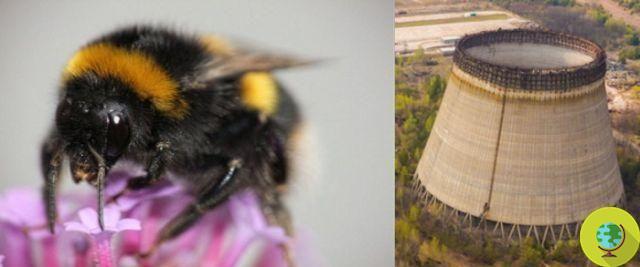
A new study has found that radiation is continuing to impair reproduction of bumblebees 35 years later
He is about to end up run over, his mother saves himFor decades, the damage that wildlife suffered in the aftermath of the Chernobyl nuclear disaster has been documented, but now a new study has found that radiation is continuing to compromise the reproduction of bumblebees, 35 years after that terrible April 26. 1986.
New research led by scientists at the University of Stirling has revealed that the reproduction rates of bumblebees living in radiation-contaminated areas, such as Chernobyl, are much more altered than previously thought.
Led by Dr Katherine Raines of the Faculty of Natural Sciences, the study shows that bumblebees exposed to radiation comparable to the similar and in some cases higher levels of Chernobyl (50-400 µGyh-1) experience lower reproductive rates and increased delayed colonies. But not only. The research has found that the impact of radiation on bumblebees can have wider consequences for the ecosystem, including a reduction in pollination due to fewer pollinating insects.
Despite extensive research, the consequences for wildlife of living in radiologically contaminated environments are uncertain. Previous laboratory studies suggest that insects are relatively resistant to radiation but some field investigations in the so-called Chernobyl exclusion zone have shown different and disturbing scenarios: here the damage reported by insects due to radiation is serious even if lower than that. foreseen.
The new research published in Proceedings of the Royal Society B: Biological Sciences, which simulated the levels of Chernobyl radiation exposure in the laboratory to investigate the impacts it could have on insects that still live in the exclusion zone, is not of the same opinion. .
According to the authors, exposure to a dose of 100 µGyh-1 could reduce bumblebees' reproduction by between 30 and 45%. As the dose increases, reproduction rates further decrease. Doses comparable to the Chernobyl exclusion zone (50-400 µGy h −1) thus impaired the reproduction of bumblebees and retarded colony growth, but did not affect their weight or longevity.
“Our research provides the necessary understanding on the effects of radiation in highly contaminated areas and this is it first search to support the international recommendation on the effects of radiation on bees, ”said Dr Katherine Raines.
The new research also found that the investigations carried out so far could have greatly underestimated the effects of radiation.
“Our data suggest that insects suffer significant adverse consequences at dose rates previously thought to be safe. Therefore, we recommend revisions relevant to the international framework for the radiological protection of the environment ”.
Once again it was animals that paid the price, including pollinating insects, fundamental for the balance of Nature and for the food security of the Planet.
Sources of reference: University of Stirling, The Royal society
READ also:
- A rare butterfly the size of a bird was discovered in Chernobyl
- Fukushima like Chernobyl: animals are repopulating the red zone after the nuclear disaster
- Chernobyl, new documents declassified: the explosion of the nuclear power plant was a "disaster announced"


























